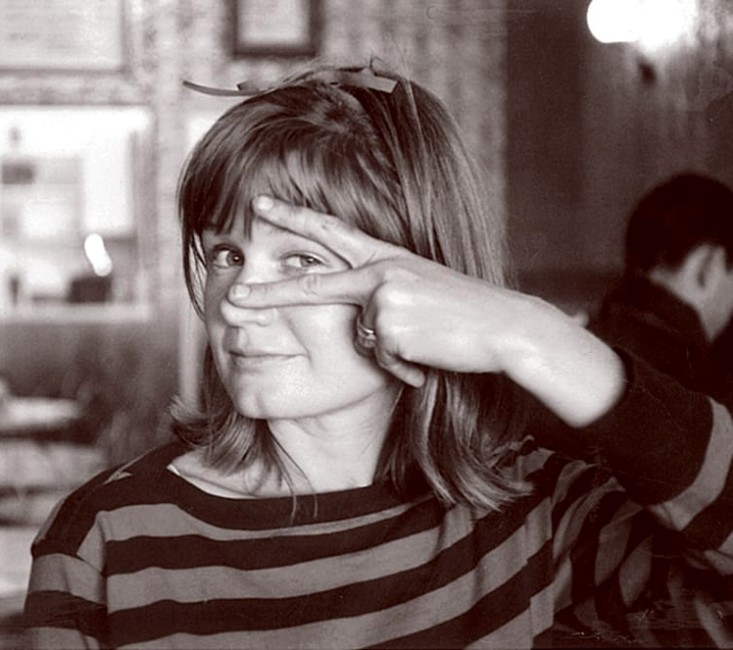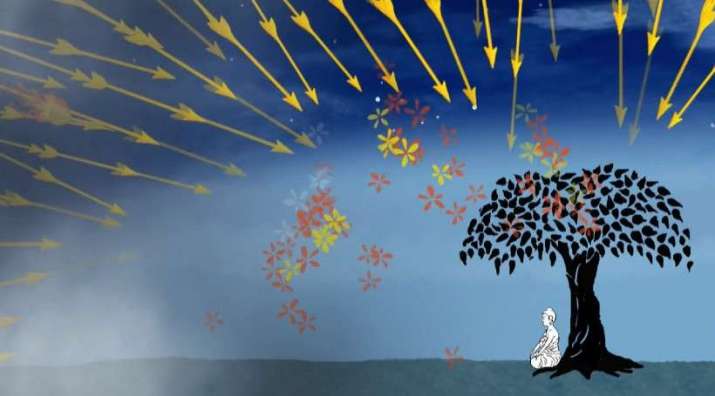FEATURES|COLUMNS|Art of Living
Break-Ups as Break-Throughs: Using Investigation to Turn Swords and Arrows into Flowers
One afternoon, at the age of 35, Deirdre Blomfield-Brown was sipping a cup of tea in front of her adobe home in northern New Mexico when she heard a car drive up behind her house. A few seconds later her husband walked around the corner and told her he was having an affair and wanted a divorce.
She was stunned. Stopped. Shocked.
Everything went silent. She noticed how huge the sky was. She saw the steam rising up from her tea. She heard the sound of the river.
“Then,” she says, “I regrouped, picked up a stone and threw it at him.”

Deirdre Blomfield-Brown in the mid-1960s. From pemachodronfoundation.org
In the months that followed, Deirdre’s anger morphed into rage. She discovered that her husband hadn’t just been having an affair; he’d been having multiple affairs.
She fantasized about breaking all the windows in his house. She thought of burning his house to the ground. She even thought of hurting the child of the woman he had left her for.
Scared by her own rage, Deirdre tried desperately to claw her way back to her former life. But nothing worked. All the king’s horses and all the king’s men couldn’t put her old life back together again. She felt “devastated” and “annhiliated.”
And it was this turn of events that gradually, over the course of many years and with a great deal of practice, transformed Deirdre Blomfield-Brown into Pema Chödrön, one of the most celebrated meditation teachers in the West . . . who now regards her ex-husband as “one of my greatest teachers.”
Why?
Because by leaving her, she says, he helped her realize she had been depending on someone outside of herself for her sense of security and self-esteem.
Because it was his departure from her life that taught her how to relate to painful emotions such as rage not by acting them out and not by repressing them but by welcoming them in with curiosity, intimacy, and warmth.
Because by leaving her, he taught her to open her heart to her own suffering, which gave her heart for all people’s suffering.
How to turn an arrow into a flower
In a sense, we might say that what happened to Pema is the same thing that, legend has it, happened to the Buddha on the night that he would attain enlightenment.
As he was sitting quietly in meditation beneath the Bodhi tree, Mara, the dark lord of desire, summoned his demon armies and commanded them to shoot clouds of swords and arrows at him. But all the swords and arrows turned into flowers.
Which means what exactly?
To Pema, it means that “what we habitually regard as obstacles are not really our enemies but rather our friends.” Why? Because, as she says: “What we call obstacles are really the way the world and our entire experience teach us where we’re stuck.”
In poet Alison Luterman’s words: “Even the word obstacle is an obstacle.”
Because what initially looks like an obstacle or an arrow or a sword—a break-up, a failure, an insult—can actually be seen as a flower. “Whether we experience what happens to us as obstacle and enemy, or as teacher and friend depends entirely on our perception of reality. It depends on our relationship with ourselves.”
 Still from The Buddha, a film by David Grubin. From pbs.org
Still from The Buddha, a film by David Grubin. From pbs.orgIn The Book of Joy (Avery Press 2016), the Dalai Lama and Desmond Tutu identify the “ability to reframe our situation more positively” as one of “the three factors that seem to have the greatest influence on increasing our happiness.”
Not long into his teaching life, the Buddha himself demonstrated this ability in what must surely be the greatest and most central reframe in Buddhist history.
According to the teaching tale of the Buddha’s life, the young prince grows up protected from the stark realities of life by the opulent walls of privilege. After 29 years of sensual bliss, he takes a series of tours outside the palace walls and is shocked to encounter—for the very first time—an elderly person, a sick person, and a dead person. And just like that his shiny bubble of pleasure is popped. Just like that he is jolted into the startling realization that he and everyone else he knows will get sick, grow old, and die.
Yet later in his life he reframes old age, sickness, and death as “divine messengers” or “gods in disguise.” Why? Because he has found peace and they are precisely what prompted him to seek it in the first place. How? By shocking him into an awareness of the fragile, flickering, and unsatisfactory nature of day-to-day life. By piercing the palace walls of his defenses and upending his mundane concerns. By startling him into making a radical change in his existential priorities and personal values.
The Pali term for this is samvega, which is usually translated as “spiritual urgency.” As Bhikkhu Bodhi explains, the word conveys “an inner commotion or shock that rouses us from our comfortable slumbers.” It was samvega that Siddartha felt when he first understood the message from the “divine messengers.” It was samvega that drove Siddartha from his pleasure palace into the wilderness to find a more satisfying response to our common existential plight. It was samvega that propelled Pema onto her spiritual path. And it is samvega that many of us—touched by so much old age, sickness, and death as of late—have been feeling since the pandemic began.

Little moments, big teachers
And what is true of the big dramatic pivot points in our lives is equally true of the little everyday aggravations. As Pema often says: “This very moment is the perfect teacher.”
Each little incident or accident that gets our goat, that pushes our buttons or drives us bananas: the way the kids just drop their jackets on the floor when they come home; that friend who only posts their golden moments on Instagram; the way your partner insists on calling the shots on the choice of Netflix shows. Whoever or whatever stirs up those old familiar feelings of irritation, resentment, jealousy, inferiority, fear, disappointment, inadequacy, embarrassment—each of these moments is the perfect teacher.
Richard Schwartz, the pioneer of Internal Family Systems therapy (IFS), calls these moments “tor-mentors” because by tormenting us they mentor us. Because if we can just stay with the sting of the “torment” —the jolt of anger, the tug of worry, the squeeze of shame—and stay really curious about it, then like a mentor it will take us under its wing and lead us to a part of us that is still stuck, still longing for our life-circumstances or our loved-ones to be different, still laboring under the weight of some outdated desire or unhelpful aversion.
And it is by spending time with these parts of ourselves, with an air of warmth and great interest, and by feeling and sensing exactly what is occurring—hot or cold, piercing or trembling, in the chest or the belly—that we are able to gather the information we need to increase our wisdom and become unstuck. Because when we pay loving attention to these parts of us, when we undertake an active and purposeful inner investigation, when we stay alert through the whole lifecycle of our difficult experiences, then the causes of our dissatisfaction have a habit of becoming clear, which not only dissolves our dissatisfaction, but helps us to recognize it if it occurs again.
As Marcel Proust observed: “We are healed from suffering only by experiencing it to the full.” And yet, as he also observed: “Griefs, at the moment when they change into ideas, lose some of their power to injure our heart.”
Or as Pema puts it: “Awareness is what turns the sword into a flower. It is how what is seemingly ugly and problematic and unwanted actually becomes our teacher.” In Pali, the particular quality of awareness she is talking about is called dhamma vicaya (investigation) and it involves simply noticing, with curiosity and kindness, precisely what is happening inside us when we are triggered.
We don't try to stop it; we just watch it, as we might watch a winter storm outside our window, or the changing landscape outside a train, or the movements of an exotic bird in a tree.
This is one way to become un-stuck: by opening and softening rather than struggling or resisting, by perking up and becoming interested when we feel like shrinking back or collapsing, or by dilating in the presence of discomfort rather than closing up like an old sea anemone.
Coming home to ourselves
It is also one way of coming home to ourselves after the end of a relationship, as Pema herself did after the end of her marriage. “This,” she writes of the process of dhamma vicaya, “is how we open our hearts. It is how we awaken our intelligence and connect with fundamental Buddha-nature.” And few people describe the end result of this process better than Derek Walcott does in his beautiful poem “Love After Love”:
The time will come
when, with elation
you will greet yourself arriving
at your own door, in your own mirror
and each will smile at the other's welcome,
and say, sit here. Eat.
You will love again the stranger who was your self.
Give wine. Give bread. Give back your heart
to itself, to the stranger who has loved you
all your life, whom you ignored
for another, who knows you by heart.
Take down the love letters from the bookshelf,
the photographs, the desperate notes,
peel your own image from the mirror.
Sit. Feast on your life.
The title, “Love After Love,” is a reminder that it is often after an external love affair ends that an internal one begins. This, after all, is usually when the part of us that has become so preoccupied with our external affairs finally comes home again, “arrives at our own door,” appears in our own mirror. After “ignoring” us “for another” for so long, it becomes available to us again, us “the stranger.” And the poem assures us with a confident air of near-inevitability, that we “will greet” this part of us, and we “will smile” at it as though we and it—our two senses of our self—are two old lovers who have kept our love alive all through the years.
This reunion between old loves is clearly not a cognitive or an intellectual or a verbal process; there aren’t a lot of words. It’s sensual, sensory, experiential—eating bread, drinking wine, feasting—and emotional—“love,” “elation,” “smile,” and “heart.” We sit with ourselves, eat with ourselves, drink wine with ourselves, spend time with ourselves. And while we feast, and look at old love letters and pictures, we just enjoy our own company and savor the love that’s been buried so long beneath that image in the mirror. We “peel” away that superficial image. We look past the crow’s feet, the blotchy skin, the big pores, the tired eyes. We go deeper until we get to that sense of self that is infinitely and unconditionally worthy and we simply look at ourselves, with love.
New wine in old bottles
This is one of the oldest reframes there is, seeing obstacles as opportunities, difficulties as learning experiences, and trials as teachers. Which, of course, is probably an indication of its usefulness. Indeed, from a purely practical perspective, one of the great advantages of the theistic traditions is that, at their best, they quickly orient believers toward the takeaways nestled in the heart of their most difficult circumstances. How? By prompting a simple yet efficient question such as: “What is God or the Universe trying to teach me through this experience?” It’s such a basic question that it is, in some ways, mind-boggling that it can take so many days or weeks or decades to ask it, never mind answer it.
But what’s less publicized is that this same ancient reframe is equally available to agnostics and atheists, provided we are willing to adopt a “philosophy of as-if” and simply act as if all the moments that trigger us have something to teach us. In other words, rather than trying to muster faith in a transcendent deity, we can, if we choose, simply regard this perspective as a potentially helpful fiction or a potentially useful psychological device.
And one of the intriguing innovations of New Age thought is its slight tweak on this old reframe. Rather than assuming that a transcendent deity has, like Aesop, embedded a simple and nourishing moral inside the hard shell of each of our nutty struggles, one of its guiding assumptions is that, prior to being born, while in a state of total honesty and complete self-awareness, we ourselves wrote into the plots of our lives all the conflicts and trials we experience in our daily lives, as if we were skilled authors or master filmmakers. Why? To create the conditions for maximum growth and evolution.
So whenever we encounter difficulties in our lives, these “self-as-author” and “school-of-life” reframes prompt us to ask ourselves: “Why would I have written this struggle or challenge into my life? What am I trying to teach myself through it?”
Again, from a pragmatic standpoint the truth-value of the reframes are beside the point. If we relate to them as metaphors or potentially useful fictions, the appropriate question to ask of them is not “Are they true?” but “Do they work?” or “Will they get me where I want to go?” or “Do they free the mind and ease the heart?”
If not, then we can drop them like they’re hot. But if they do, we can run with them. And while running with them, we can hold them however we wish: lightly like a delicate picture frame or casually with a hand on our hip, or ironically with our tongue in our cheek. And then, when they no longer serve us, we can simply set them down, like Wittgenstein’s ladder, which he recommended we throw away after we’ve climbed up it. Or we can leave them behind altogether, like the Buddha’s teachings, which he compared to a raft that is “for getting across” the river of suffering, “not for retaining.”
References
Bodhi, Bhikkhu. 2017. Dhamma Reflections: The Collected Essays of Bhikkhu Bodhi. Kandy: Buddhist Publication Society.
Chödrön, Pema. 1996. When Things Fall Apart. New York: Random House.
Related features from Buddhistdoor Global
Let Clinging Be Your Teacher
Bodhisattva Work: Bringing One’s Heart to Financial and Life Planning
The Gift of Painful Feelings: The Benefits of Opening Up to Unpleasant Emotions
Buddhistdoor View: How to Be Happily Unhappy
Dharma In The Digital Age: Susan Piver
Buddhistdoor View—Why Buddhism is Not All About the Search for Happiness
Spiritual Bypassing and the Dangers of Unresolved Emotional Wounds
More from Art of Living by Seth Shugar














